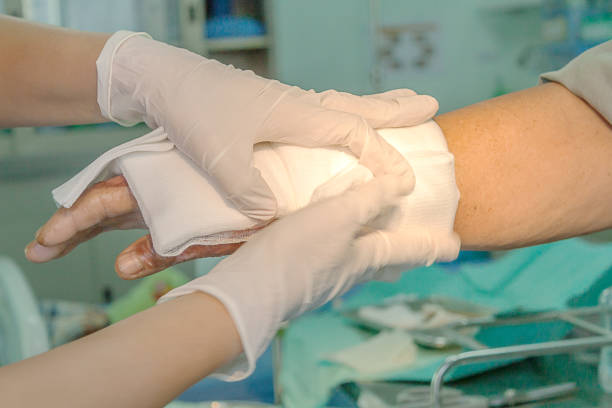Burn dressing are advanced wound care materials designed to protect burn wounds, manage pain, and promote healing of the skin. These dressings can take many shapes, including hydrocolloid, hydrogel, and silver-infused pads, each playing a unique role.
Some burn dressings retain moisture, which enhances healing and reduces scarring. Most incorporate materials such as fine-mesh gauze, tulle gras, or silicone sheets. Other dressings, like silver dressings, work to prevent infection.
Others adhere snugly to the dermis, reducing trans-epidermal water loss and helping retain body temperature. Individuals frequently apply these dressings to acute burns or post-operative wounds. For minor burns, this means changing the dressing once a day.
Fast application, within 12 hours, provides improved outcomes and increased patient comfort.
Choosing the Right Burn Dressing
Choosing the right burn dressing begins with understanding the depth and size of the burn. Burns are classified into categories according to their depth—superficial, partial, or full thickness. Each type requires its own unique dressing.
If you have a small, blistered burn, polyurethane film protects and promotes healing better than gauze. If the burn is partial-thickness, silicone-coated nylon dressings typically provide superior pain control to silver-based creams.
Biosynthetic dressings and hydrogels similarly accelerate healing and pain relief, although hydrogels might require fewer replacements. For infected burns, antimicrobial silver dressings are effective against infection.
Hydrocolloid dressings are effective for superficial burns, and advanced antimicrobial dressings support the needs of high-risk wounds. Discussing any concerns with a physician is important.
At Phoenix Plastic Surgery Centre, we pride ourselves on creating individualized care plans to address our patients’ specific needs.
How Dressings Aid Healing Process
The role of dressings in burn healing is crucial. They form a moist environment over the wound that speeds the development of new skin. They avoid loss of water vapor, stopping the wound from drying out and allowing the skin cells underneath to heal more quickly.
Both moistened occlusive dressings, and modern hydrogels promote wound healing at least two-fold. Other dressings help manage pain by creating a gentle protective cushion, minimizing exposure to air and external irritants.
Additionally, some dressings, such as antimicrobial or transparent film dressings, prevent infection and allow physicians to examine the wound without removing the dressing. At Phoenix Plastic Surgery Centre in Bangalore, dressings are changed by specialists regularly to keep the wound clean. This attentive treatment encourages robust healing.
Applying and Changing Dressings Safely
Applying burn dressings starts with washing hands and cleaning the area with mild soap and water, keeping the wound free from dirt and germs. With silver dressings, moistening with sterile water increases silver release, but saline may decrease it.
Some people choose wet gauze, followed by dry gauze, and finally a bandage or adhesive. Polyvinyl chloride film is effective for three to four days, and even up to a week on occasion. Nanocrystalline dressings are most effective when changed every two days.
After 24 hours have passed, look for any leaking or a change in color. For change, soak wraps in water or use adhesive remover spray to get old wraps off with less irritation. Look for signs of infection, like increased redness, swelling, drainage, or odor and return to the health care provider regularly for wound care.
- Do keep hands clean and use sterile tools.
- Do moisten silver dressings with sterile water only.
- Do watch for signs of infection: redness, swelling, pus, smell.
- Do check dressings after 24 hours.
- Do change dressings every 3–5 days or as advised.
- Don’t use saline with silver dressings.
- Don’t pull off dressings dry.
- Don’t skip check-ups with your doctor.
Beyond Dressings: Plastic Surgery Options
For individuals with extensive burns or lesions that fail to heal with traditional dressings, reconstructive surgery provides a fresh start. During this procedure, first the surgeon examines the depth and width of the burn. This can guide the selection of the most appropriate treatment, such as skin grafts or flap repair.
Skin grafts transfer healthy skin from another area of the body to cover a wound. Flap surgery involves re-positioning tissue with its own blood supply for more difficult areas. Either route can improve appearance and aid in improved function.
Recovery can be a long process that requires rehabilitation and pain management. Others might be left with prominent scars or loss of sensation.
Dr. Raghavendra Kaladagi pioneered this technique at Phoenix Plastic Surgery Centre in Bangalore. He artfully employs the most advanced techniques to accelerate healing while using his plastic surgery skills to return people to a state of completeness.
Optimizing Burn Care for Everyone
Burn care calls for a clear look at the needs of kids, older adults, and folks in varied places. In busy cities, quick care helps most, but in lower-income spots, people lean on things like honey, plant juices, and even papaya for wounds.
Silver sulfadiazine cream stands out—safe, cheap, works well, and most folks stick with it. Where money runs tight, boiled potato peels or amniotic membranes cut costs and speed up healing.
To get care to more people, it helps to share tips, train first responders, and keep clinics stocked. At Phoenix Plastic Surgery Centre in Bangalore, teams give hands-on support, custom care, and advice for scar healing.
Recovery means more than dressings—support groups and rehab matter too.
Our Commitment to Burn Reconstruction Surgery and Care
Phoenix Plastic Surgery Centre is truly exemplary in its individualized care for burn patients. Under the direction of Dr. Raghu, the team’s leader, he demonstrates his wealth of knowledge in the field of burn reconstruction while offering encouragement and support.
Their approach covers every step, from first aid like gentle daily cleaning and antibacterial ointment to advanced choices like Biobrane dressings, left for up to a month, and tissue expanders filled with saline over weeks. The team is very much on top of healing timelines.
When wounds heal in 14 to 21 days, they prescribe pressure garments and begin crafting specialized gear three to four weeks after the wounds fully heal. Reliable and consistent care is key to healing.
They monitor splints and dressings at five days post grafts and offer splints to support scar contracture which can develop months later.
Conclusion
The burn dressings are most effective when applied with proper care and technique. They promote the healing of new skin, reduce pain and potential scarring. Whether from a hot stove, firecrackers, or other common kitchen accidents, burns are a real consequence that people in Bengaluru face. An optimal dressing protects wounds from outside elements and prevents contamination. The dressing you choose is the largest factor affecting healing. No matter the step, quick swaps and clean hands go a long way! When contractures, chronic pain, or prolonged wound healing occur, patients seek out professional treatment.
Phoenix Plastic Surgery Centre is always available for assistance, consultation, or complex repairs. Whether it’s in-person or virtual, the team listens, explains, and tailors care to each individual. If you are looking for advanced skin burn treatment, then head to the Phoenix Plastic Surgery Centre in Bangalore. Schedule your appointment today!
Emergency Cases
Frequently Asked Questions
What are burn dressings used for?
How do I know which burn dressing to choose?
How often should I change a burn dressing?
Can dressings speed up the healing process?
How do I safely apply a burn dressing at home?
Are there surgical options if dressings aren’t enough?
Why trust Phoenix Plastic Surgery Centre, Bangalore for burn care?

